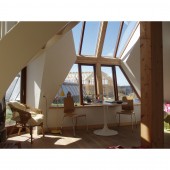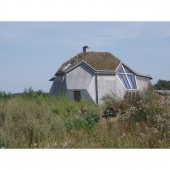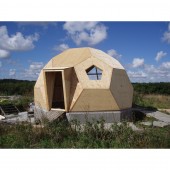
| THE AWARD |
| CATEGORIES |
| REGISTRATION |
| SUBMIT YOUR WORK |
| ENTRY INSTRUCTIONS |
| TERMS & CONDITIONS |
| PUBLICATIONS |
| DATES & FEES |
| METHODOLOGY |
| CONTACT |
| WINNERS |
| PRESS ROOM |
| GET INVOLVED |
| DESIGN PRIZE |
| DESIGN STORE |
| THE AWARD | JURY | CATEGORIES | REGISTRATION | PRESS | WINNERS | PUBLICATIONS | ENTRY INSTRUCTIONS |
Easy Domes Dome House by KT Architects |
Home > Winners > Design #26583 >Interview |
 |
|
FS: What is the main principle, idea and inspiration behind your design?
KT: The main principles behind the Easy Domes design is the geodesic structure carried out from the basic of the regular polyhedra the Icosahedron where the vertices are cut off and the holes closed as faces in the new polyhedron. The new solid becomes a pure plate system which is stable and therefor useable as load and construction of a climate membrane. At the architectural study in Copenhagen in the 70ties the geodesics had a renaissance from works of Richard Buckminster Fuller, even no real full scale project was made. Inspired by the ”buckeyballs” the idea and development of the first world wide full scale dome occur by request from the Society of Greenland People on Faroe Islands. A reasonable sized cultural house, with good interior and built for Greenland people in middle of traditional family houses, could not be the traditional ”buckeyball”. A too strange, almost alien house, set the challenge to simplify the idea though reaching the expression of the ”igloo” - the Eskimo house. Further developments especial minimizing the load demands led to small full scale domes built in mountain terrain and ruff climate. Tests had to be made for some years, the building technique experience and knowledge was gathered to a success for later industrial production at a highly sophisticated and modern factory in Denmark.
FS: What has been your main focus in designing this work? Especially what did you want to achieve?
KT: The focus was from beginning the simplification of the fully ball-shaped geodesic dome. Benefits were reached as the plate structure had no demands for special steel connectors which are common at the lattice building technique.
FS: What are your future plans for this award winning design?
KT: The plans are to offer sustainable and pre-produced building sections for anybody – private, company or institution – who wants a high quality house. Marketing works are ongoing and a lot of interest is established from all around the world. A part of the future plan is to have contact and establish a local production in countries where many people might not have the big opportunities to have a good and strong house capable of standing against hurricanes and earthquakes. In short terms to make it possible for low income groups in third countries to build their own house based on the very strong wooden dome construction. No special connectors, simple tools, easy to repair and offering a broad range of possibilities for outside coverage from local nature materials.
FS: How long did it take you to design this particular concept?
KT: The first full scale dome was quite a challenge, especial the calculation for strength of the construction to fulfill climate and wind speed forces. In cooperation with my building engineer, ass.prof. at the Royal Academy of Fine Arts, Architectural Department, Copenhagen, Mr. Ole Vanggaard, the design and construction development was worked out for approximate 1 year.
FS: Why did you design this particular concept? Was this design commissioned or did you decide to pursuit an inspiration?
KT: The concept was developed as a result of the commissioned project by the Society of Greenland People on Faroe Islands.
FS: Is your design being produced or used by another company, or do you plan to sell or lease the production rights or do you intent to produce your work yourself?
KT: The design is offered as a building kit in different sizes and to individual wishes from customers. Cooperation and agreement is made with the danish factory Taasinge Trae to produce the wooden plate sections, and my company makes the marketing work.
FS: Who is the target customer for his design?
KT: Interested customers to this special design and solution for cost effective housing are people with low income, people who look for spiritually significant structures, and people who look for a quite different and new architecture fulfilling demands for green and sustainable buildings. Also some customers want a high quality more luxury housing, or it might even be intentions for tourism purposes, atelier, workshop, café and similar traditional arrangements.
FS: What sets this design apart from other similar or resembling concepts?
KT: Comparable design is the lattice geodesic structure – the Jing and open structure, while this has the Jang and closed plate structure. Also a big difference is that no special connectors are needed for mounting the dome structure, compared to the lattice principle which needs special steel connectors.
FS: How did you come up with the name for this design? What does it mean?
KT: The name for the design is first the dome design next the very easy way to build the dome.
FS: Which design tools did you use when you were working on this project?
KT: The first example was made by traditional architectural tools: the pencil, ruler, protractor and calculator. Further works are computerized and in AutoCad drawings. Modelling works was also a part of the first development..
FS: What is the most unique aspect of your design?
KT: The most unique aspect is the cut of the vertices of the icosahedron offering the construction of wooden plate structures.
FS: Who did you collaborate with for this design? Did you work with people with technical / specialized skills?
KT: The design and construction work was made in cooperation with ass.prof. Mr.Ole Vanggaard from the Architectural Academy in Copenhagen. Very few building engineers have needed skills and knowledge for calculations of load demands for geodesic structures.
FS: Is your design influenced by data or analytical research in any way? What kind of research did you conduct for making this design?
KT: Some research was made in the 60ties and 70ties at architectural schools in the field of geodesic structures as sinus related transformed shells. The simplified design from cut of vertices of the icosahedron had not been a special topic, but the knowledge was available even the full scale example had not been built previous
FS: What are some of the challenges you faced during the design/realization of your concept?
KT: The biggest challenge was to reach a wooden load construction as thin as possible managing the load demands. Further challenge was to produce the structure and find an easy technique on mounting the sections to each other.
FS: How did you decide to submit your design to an international design competition?
KT: The design has not been built in a full scale structure, so I thought this might reach some interest at an international design competition.
FS: What did you learn or how did you improve yourself during the designing of this work?
KT: Best improvement by development of the design has been the experience of the combination of theory and practice and the development through new computerized programs in combining materials to fully sustainable buildings.
FS: Thank you for providing us with this opportunity to interview you.
A' Design Award and Competitions grants rights to press members and bloggers to use parts of this interview. This interview is provided as it is; DesignPRWire and A' Design Award and Competitions cannot be held responsible for the answers given by participating designers.
| SOCIAL |
| + Add to Likes / Favorites | Send to My Email | Comment | View Press-Release | Translations |





